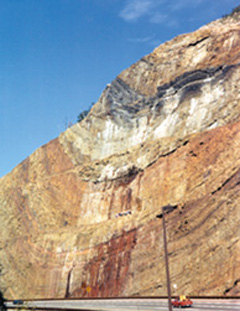|
Where on Earth? Answer Archive
To submit an answer to the current Where
on Earth? click
here.
To offer photographs for Where
on Earth? send an E-mail message to earth@earthmagazine.org.
2001: January February March April May June July August September October November December
2002: January February March April May June July August September October November December
2003: January February March April May June July August September October November December
2004: January February March April May June July August September October November December
2005: January February March April May June July August September October November December
2006: January February March April May June July August September October November December
2007: January February March April May June July August September October November December
2008: January February March April May June July August
December 2003
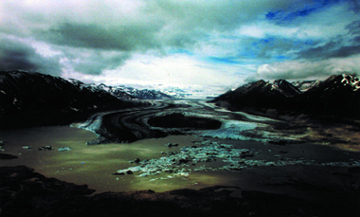
|
Clues: 1. Located in a World Heritage Site, this location is part of the largest protected area in the world, straddling the border between two nations. 2. It is believed to be the site of the largest Neoglacial ice-dammed lake in the world. The ice-dammed lake filled and emptied numerous times; the most recent significant lake formed in the 1800s and, when the ice dam burst, drained 40 cubic kilometers of water in a two-day period. 3. The glacier was named for the president of an academic institution that is the oldest on its continent. Name the glacier. Scroll down for the answer |
| Answer: Alsek River, Lowell Glacier. Clues and photo submitted by Paul Butler, Olympia, Wash. |
December 2003 Winners
1. John Atkinson (Salt Lake City, Utah)2. Steve Blair (Edmond, Okla.)
3. Jason Buck (Eureka, Calif.)
4. Sandra Cannon (Oceanside, Calif.)
5. Robert Goodwin (Omaha, Neb.)
6. Charles Gilchrist (Clifton Park, N.Y.)
7. Peggy Lorge (Fernley, Nev.)
8. Erin Moore (Tucson, Ariz.)
9. Jeff Ritchie (Wichita Falls, Texas)
10. John B. Williams (Sacramento, Calif.)
November 2003
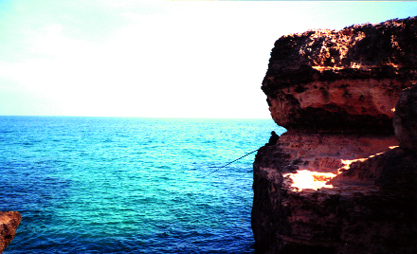
|
Clues: 1. Although sometimes called the "Land Between Two Seas," this peninsula is perhaps better known as the back end of an enormous item of footwear. 2. Carbonate rocks in this region were laid down throughout the entire Cretaceous period. These thick sequences of rock were rapidly uplifted and exposed in the Middle Pleistocene when thick continental lithosphere buckled in the hinge of an adjacent subduction zone. 3. A prominent town in the region is named "beautiful city" in a classical tongue, a sobriquet shared with the site of a 1915 battle that was a turning point for Australia's national identity. Name the region. Scroll down for the answer |
| Answer: Puglia is the southeasternmost region of Italy stretching between the Ionian and Adriatic Seas; it is the heel of Italy's boot. Photo by Megan Sever. |
November 2003 Winners
1. Mike Antolik (Cambridge, Mass.)
2. Caitlin Bergin (Cambridge, Mass.)
3. Martha Carr (Atlanta, Ga.)
4. Nancy L. Ferry (Edgewood, Wash.)
5. Felix Frey (Wettswil, Switzerland)
6. Alan Marshall (Nedland, Australia)
7. William J. Pegram (Arlington, Mass.)
8. Joshua Rilying (Rochester, Ill.)
9. Mae Soo Hoo (Sacramento, Calif.)
10. John B. Williams (Sacramento, Calif.)
October 2003
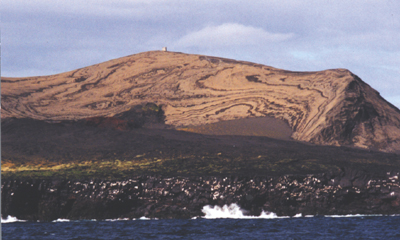
|
Clues: 1. Born in a burst of explosive fury in 1963, this oceanic volcano continued to erupt until 1967. After it had built a tephra cone up from the ocean floor, its eruptions became less violent, and basaltic flows poured out onto its flanks. 2. The island is a sanctuary off-limits to casual visitors, to enable scientists to observe and record its pristine ecologic development. Green plants and abundant seabirds have established colonies above its shores. 3. The island is named after a Norse god of fire. Scroll down for the answer
|
|
Answer: Surtsey volcano, about 35 kilometers southwest of Iceland in the North Atlantic Ocean. Photo and clues provided by Wallace Hansen of Lakewood, Colo. |
October 2003 Winners
1. Polly Bass (Athens, Ga.)
2. Heather Brown (Vancouver, B.C.)
3. William A. Crawford (Bryn Mawr, Pa.)
4. Ken Ferrone (Concord, Calif.)
5. Steven R. Gustison (Champaign, Ill.)
6. Art Johnson (Kenner, La.)
7. Keith Meldahl (Encinitas, Calif.)
8. Rachel Paull (Littleton, Colo.)
9. John Reid (Fort Collins, Colo.)
10. Don Wason (Barrington, N.H.)
September 2003
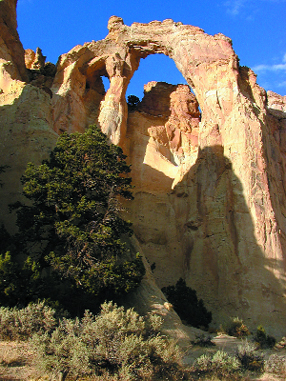
|
Clues:
1. The rock in the cliff was once a Jurassic sand sea. 2. This feature is named for a man who was president of what is today the largest nonprofit scientific and educational institution in the world. He was also editor of their yellow-fringed magazine. 3. The national government set aside the site in 1996 despite strong opposition from most local politicians.
Scroll down for the answer
|
|
Answer: Grosvenor Arch, formed from Navajo sandstone, is a prominent feature of the Grand Staircase-Escalante National Monument in Utah. Photo supplied by Thomas McGuire. |
September 2003 Winners
1. Jason Bateman (New Paltz, N.Y.)
2. Lynne Beatty (Shawnee Mission, Kan.)
3. William Bilodeau (Thousand Oaks, Calif.)
4. Wallace R. Hansen (Lakewood, Colo.)
5. Jeff Kirtland (Seattle, Wash.)
6. Christine Reed (Ballston Spa, N.Y.)
7. David Sitzler (Rio Rancho, N.M.)
8. William L. Smith (McLean, Va.)
9. Paula Stine (Decatur, Ill.)
10. John Williams (Sacramento, Calif.)
August 2003
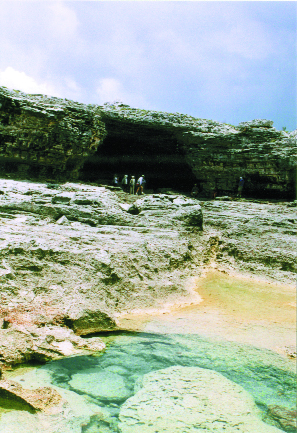
|
Clues:
1. The karst-forming rock formed during the Pleistocene. 2. The clastics found in this area came from the Sahara Desert. 3. The first settlers to the area were freedom seekers who met as a colony for a religious service of thanksgiving in a cave such as the one shown here. Indeed, the name of this land comes from the word for freedom.
Scroll down for the answer
|
|
Answer: Eleuthera, one of the islands of the Bahamas. Photo by Judy Marshall. Contributed by Jacq Marie Jack. |
August 2003 Winners 1. John Grace (Kalamazoo, Mich.)
2. David Pratt (Katskill Bay, N.Y.)
3. Steven Paul Rewa (East Lansing, Mich.)
4. Kelley Steffen (Miami, Fla.)
5. George Veni (San Antonio, Texas)
6. Liz Victor (Jacksonville, Fla.)
7. Michael J. Zaleha (Springfield, Ohio)
July 2003
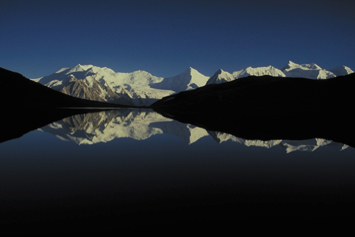
|
Clues:
1. These mountains, with the greatest concentration of high peaks, vie for the title of world’s tallest. 2. A rugged valley that dissects these mountains was the inspiration for the mythical Shangri-La. 3. The lake in the foreground is nearly 5500 meters above sea level.
Scroll down for the answer
|
|
Answer:
Karakoram Mountains of northern Pakistan (near Gilgit). Photo courtesy
of Richard
Kelly, NASA. |
July 2003 Winners:
1. Brett Bersche (Springfield, Ill.)
2. Paul English (Calgary, AB, Canada)
3. Peter Forman (Albany, N.Y.)
4. Safdar Gill (Chicago, Ill.)
5. Kent Keller (Oklahoma City, Okla.)
6. Shauna McDonald (Sebastopol, Calif.)
7. Donald P. Schwert (Fargo, N.D.)
8. Harry Siebert (Dolores, Colo.)
9. M. Winter (Woodland Hills, Calif.)
10. Ann Youberg (Tucson, Ariz.)
June 2003
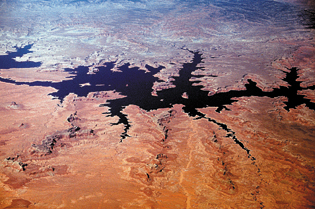
|
Clues:
1. By this spring, prolonged drought had dropped the water level in this desert lake by nearly 100 feet, leaving it half empty. 2. The most common rock type in the area formed from a sand sea during the Jurassic period. 3. More recent sediments are filling the dammed lake at a rate that some say could fill it within 100 years. Others argue it could take 700 years.
Scroll down for the answer
|
|
Answer:
Lake Powell in Utah. Photo is by Bruce Molnia of USGS and was supplied
courtesy of the American Geological Institute archives. |
June 2003 Winners:
1. Brianna Bailey (Springfield, IL)
2. John W. Bartley (Muskegon, MI)
3. Chris French (Denver, CO)
4. LeRoy Long (Edmond, OK)
5. Christopher McMichael (Knoxville, TN)
6. Jonathan Moll (Northfield, VT)
7. Jack Rigg (Camarillo, CA)
8. Marty Rutstein (New Paltz, NY)
9. Richard P. Smith (Nathrop, CO)
10. Stephen Wust (Santa Fe, NM
May 2003
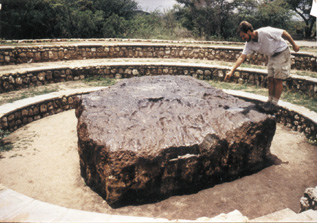
|
Clues:
1. The object in this photograph weighs more than 50 tons, has a volume of 9 cubic meters and hit the ground about 80,000 years ago. 2. It is made up of 82 percent iron, 16 percent nickel and 1 percent cobalt as well as various trace elements. Its main minerals are kamacite and taenite. Thin sections show intergrowth of the kamacite and taenite needles in Widmanstätten structure. 3. It is located in the world’s second most sparsely populated country. .
Scroll down for the answer
|
|
Answer: Hoba Meteorite, Namibia |
May 2003 Winners:
1. Les P. Beard (Oak Ridge, TN)
2. Matthew J. Cohrt (Rohnert Park, CA)
3. Diane M. Erwin (Berkeley, CA)
4. Jay W. Hodny (Elkton, MD)
5. Peter McCorquodale (Berkeley, CA)
6. Robert Mitchell (Dixon, CA)
7. Daniel Phelps (Lexington, KY)
8. Kitty Presnell (Eureka, MT)
9. Alan Rubin (Los Angeles, CA)
10. Peggy Skill (Arlington, WA)
April 2003
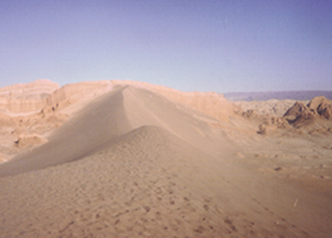
|
Clues:
1. This national monument is located within a region reputed to be the most arid on Earth. Under these extreme conditions, mineral deposits create multi-colored rows of wind-eroded hills and stratified rock formations. In many areas, dramatic natural sculptures or pillars of eroded salt deposits stand guard over the landscape. 2. The barren formations of this national monument appear to belong more to a lunar landscape than a terrestrial one. Visitors are encouraged to explore the area under the light of a full moon, which produces eerie shadows and hues. 3. The region contains not only a wealth of well-preserved archaeology, but also valuable minerals, including one-fifth of the world’s copper reserves.
Scroll down for the answer
|
|
Answer: Valle de la Luna (Valley of the Moon) National Monument in Chile, South America, Atacama Desert. Photo and clues supplied by Geotimes reader Mark Twede of Redding, Calif. |
April 2003 Winners:
1. Caspar M. Ammann (Boulder, CO)
2. Steve Blair (Edmond, OK)
3. Alejandro Franco (The Woodlands, TX)
4. Ray Harris (Tucson, AZ)
5. Richard Harwood (Moline, IL)
6. Dan King (Galloway, NJ)
7. Kimberly Maxeiner (Chatham, IL)
8. Siegfried Muessig (Pasadena, CA)
9. Hilde Proffett (Eagle River, AK)
10. Barbara Rudnick (Philadelphia, PA)
March 2003
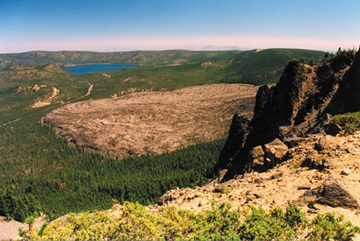
|
Clues:
1. The glassy flow in the center of the picture formed 1,300 years ago in the last eruption of this Quaternary shield volcano, one of the largest volcanoes in its country. 2. This photograph of the summit caldera was taken from the volcano's current high point, a peak named for a local chieftain who, one might surmise, was no stranger to peril. 3. The town just to the north has an unbreakable name that stems from a curve in the adjacent river.
Scroll down for the answer
|
|
Answer:
Newberry Volcano; Oregon, United States.
The collapsed caldera of the Newberry volcano with Big Obsidian flow is
in the center of the image. Newberry is located 14 miles south of Bend,
Ore., on the Deschutes River. Photo supplied by Andrea Ferguson and taken
by her husband Jim Ferguson. |
March 2003 Winners:
1. John W. Boyd (Prescott, Ariz.)
2. Daniel Deborde (Tucson, Ariz.)
3. Peter Druschke (Las Vegas, Nev.)
4. Richard W. Galster (Edmonds, Wash.)
5. Neal Jacques (Seahurst, Wash.)
6. Milton R. Marks (Lake Oswego, Ore.)
7. Charna Meth (Alexandria, Va.)
8. Andrew H. Rorick (Sandy, Ore.)
9. Marty Ross (Rockport, Mass.)
10. Todd Shipman (Tucson, Ariz.)
February 2003
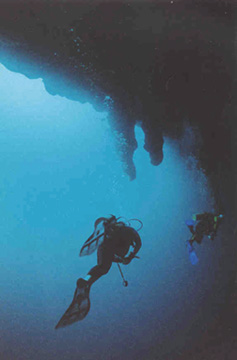
|
Clues:
1. Now underwater, this feature was a subaerially exposed cave during the last Ice Age approximately 18,000 years ago. More than 400 feet deep, it was thought to be bottomless until the French explorer Jacques Cousteau proved otherwise during a 1970 expedition. 2. Researchers are using core samples from stalactites like those pictured to test a hypothesis that relates Saharan desert dust storm activity to the development of algal blooms and other pathogens in this region. 3. The feature’s name and its appearance from the air are similar to that of an astronomical feature with a gravitational field so intense that not even light can escape.
Scroll down for the answer
|
|
Answer:
Great Blue Hole, Lighthouse Reef Atoll, Belize. Photo supplied by Steve
Blair. |
February 2003 Winners:
1. Noreen A. Buster (St. Petersburg, FL)
2. Robert F. Dill (San Diego, CA)
3. Robert G. Dunn, Jr. (Viburnum, MO)
4. Jack Faughn (Portland, OR)
5. R. J. Gauthier-Warinner (Arlington, VA)
6. Andy Parker (Webb City, MO)
7. Deborah Carter Peoples (Delaware, OH)
8. Chris Robinson (Wyoming, MI)
9. William Speidel (San Diego, CA)
10. Peter Trabant (Houston, TX)
January 2003
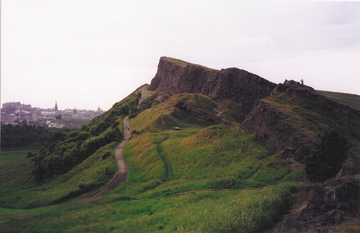
|
Clues:
1. Although this Carboniferous teschenite sill shares its name with a cathedral that has the highest medieval spire in the world, the two namesakes sit at opposite ends of their island nation. 2. The “father of modern geology” used a section at the base of the sill to argue that an injection of molten rock had broken apart existing sedimentary layers. This observation contradicted the prevailing Neptunist theory that all rocks settled out of the noachian flood. 3. At the far upper left, a castle sits on a volcanic plug of similar age to the foreground sill. Despite the sheer walls provided by the extinct volcano, the castle was repeatedly under siege during the region’s wars of independence.
Scroll down for the answer
|
|
Answer:
Salisbury Crags; Edinburgh. Photo by David Applegate. |
January 2003 winners:
1. Dale C. Andrews, Pittsburgh, Pa.
2. Kirby Cockerham, Englewood, Colo.
3. Larry Davis, West Haven, Conn.
4. Margaretha Eckhardt, Arlington, Mass.
5. David Grisafe, Lawrence, Kan.
6. Anthony R. Kampf, Los Angeles, Calif.
7. John Longshore, Arcata, Calif.
8. Candy Martinez, Fremont, Calif.
9. Maria Skidmore, Warrington, Pa.
10. Jerry Tarbell, Hampstead, Md.
December 2002
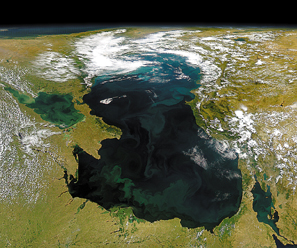
|
Clues:
1. According to one popular theory, this
body was a freshwater lake during the last ice age before rising sea level
forced a connection through a narrow opening with a neighboring sea. Today,
the body is saline with depths exceeding 2,000 meters. 2. Agricultural and other types of runoff are a major problem for this
body of water, which receives the outflow of the second, third and fourth
largest rivers of an adjoining “continent.” 3. The peninsula at center left was the site of a war in the 1850s and a cinematically famous mutiny in 1905.
Scroll down for the answer
|
|
Answer: The
Black Sea. Photographed by the OrbView-2 satellite on June 17, 1999, as
part of the SeaWIFS Project. |
December 2002 Winners:
1. Raili Aumo (Espoo, Finland)
2. Wesley Crawford (Austin, TX)
3. Gail L. Ferry (Edgewood, WA)
4. Gina Iwahashi (Oakdale, CA)
5. Don Lindasy (Bakersfield, CA)
6. Liz Miller (El Cajon, CA)
7. Matthew B. Morris (Pittsburgh, PA)
8. Bill Rice (Kingsford, MI)
9. Graham Silsby (Havre de Grace, MD)
10. Don Tobin (Houston, TX)
November 2002

|
Clues:
1. As impressive as this cliff looks, what is truly impressive is down below — the deepest known cave in the Western Hemisphere. 2. The cliff and cave are part of a karst terrain formed in Cretaceous limestone. 3. A fatal 1994 expedition established a new hemispheric record for the deepest that humans have traversed underground. Name the body of water. Scroll down for the answer
|
|
Answer: Huautla Plateau, Oaxaca, Mexico. Photo supplied by Barbara am Ende and taken by Bill Stone. |
November 2002 winners:
1. Dan Bulger (Waukegan, IL)
2. Bruce Johnson (Naples, FL)
3. Suzie Opalka (Hollis, NH)
4. Mike Ranck (Socorro, NM)
5. Frank Lynham (Westbrook, ME)
6. Harry TerBest, Jr. (Franktown, CO)
7. Steven Paul Rewa (East Lansing, MI)
8. Jim Sukup (Carmel, IN)
9. Louise Hose (Orange, CA)
10. Arthur N. Palmer (Oneonta, NY)
October 2002

|
Clues:
1. Part of an area called “sacred waters”
in the local language, this spring is 25 kilometers south of an island
city founded in the 14th century. 2. The bubbly, hot spring pool derives its name from the character of its thermal waters. Fed by groundwater, it sits in a hydrothermal eruption crater that formed about 900 years ago. 3. Orange precipitates visible around the rim of the pool are rich in arsenic, antimony, mercury and thallium, and contain ore grades of gold and silver. This suite of elements highlights the fact that this geothermal system is an active analogue of systems that form epithermal gold deposits in volcanic arcs.
Scroll down for the answer
|
|
Answer: Champagne Pool hot spring in the Waiotapu Thermal Reserve, Central North Island, New Zealand. Supplied by Jeff Hedenquist of Ottawa, Canada. |
October 2002 Winners:
1. Rick Allis, Salt Lake City, Utah
2. Raili Aumo, Espoo, Finland
3. John Balla, Spokane, Wash.
4. Steve Blair, Edmond, Okla.
5. Kurt Brownell, La Crosse, Wis.
6. Sandra Cannon, Oceanside, Calif.
7. Remi duBois, Bellows Falls, Vt.
8. L. Duane Dungan, Cape Coral, Fla.
9. Aaron R. Phillips, Joplin, Mo.
10. Thomas L. Shaw, Lakeland, Fla.
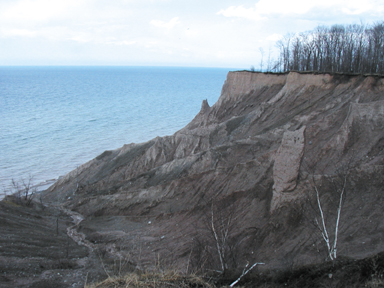
|
Clues:
1. These erosional features are the remains of a truncated drumlin. High spires, pinnacles, cliffs and hoodoos rise up to 150 feet above the shore line and suggest a tall, stacked appearance. Photographs of the area show dramatic morphological changes due to coastal erosion over the past century. 2. This spectacular badlands topography formed on the shore of the world's 14th largest lake (by area), the name of which is a corruption of one bestowed on it in 1660 by the explorer, Creuxius. It translates as "beautiful lake." 3. The area was first settled in the late 1700's, and the elementally
named point nearby has one of the country's oldest lighthouses, built
in 1871 to replace an older deteriorated one dating to 1824. Name the feature and the lake. Scroll down for the answer
|
|
Answer: Chimney Bluffs State Park is located on the southern shore of Lake Ontario midway between Rochester and Oswego, N.Y. Photo by Daniel Blumberg. |
September 2002 winners:
1. Al Bashford, Sydney, Australia
2. Steve Blair, Edmond, Okla.
3. Teresa Doherty, Syracuse, N.Y.
4. Paul Dudley, Pittsford, N.Y.
5. John J. Fontanella, Albany, N.Y.
6. Glenda Mahin, Reno, Nev.
7. Dave Nemetz, Madison, Wis.
8. Jeannine Perrot, Houston, Texas
9. Brian Peterson, Ithaca, N.Y.
10. Mark Varhaug, Dallas, Texas
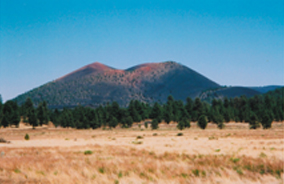
|
Clues:
1. This volcano is part of a volcanic field active for 6 million years. Its most recent eruption forced the people of the area to flee. Although they returned to farm for another century, their civilization is now known only from archaeological remains. 2. A famous, one-armed geologist described the site after an 1885 visit: "A portion of the cone is of bright reddish cinders, while the adjacent rocks are of black basalt. The contrast in colors is so great that on viewing the mountain from a distance the red cinders seem to be on fire," Its name, however, is derived from a more celestial flame. 3. This site was given government protection
in 1930 after local outcry stopped a film studio from creating a landslide
on its slopes for a scene in a disaster flick they were shooting. Scroll down for the answer
|
| Answer: The Sunset Crater in the Sunset Crater National Monument near Flagstaff, Ariz. Photo supplied by Perle M. Dorr. |
August 2002 winners:
1. Douglas Albach (Reva, VA)
2. Roger J. Bain (Akron, OH)
3. Paul Bogseth (Lagnua Niguel, CA)
4. Ann Coppin (Westminster, CA)
5. J. M. Kelly (Lakewood, CO)
6. Richard E. Kimmel (Apopka, FL)
7. Linda Lewis (Richardson, TX)
8. Kevin B. Marvel (Washington, DC)
9. Norman Meek (San Bernardino, CA)
10. Charles Plummer (Sacramento, CA)
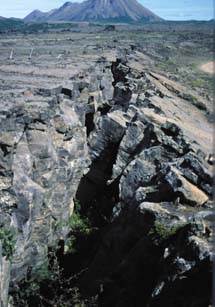
|
Clues:
1. The fissure pictured here is one of many located within a prominent rift system that extends for nearly 15,000 kilometers. 2. Located a few kilometers northeast of the area shown in the picture is one of the country's most active volcanoes and a few kilometers southwest is a prominent lake named for the midges that swarm to it. 3. Between 1725 and 1729, the volcano and
its associated fissure system created a large lava flow that eventually
reached the north shore of the lake near the present day location of a
major geothermal plant. The most recent eruptions associated with this
volcano occurred between 1978 and 1984. Name the geologic structure and country, as well as the nearby lake or volcano. Scroll down for the answer
|
| Answer: The Mid-Atlantic Ridge as it stretches through Iceland near Lake Myvatn and Mount Krafla. Photo by Henry Berryhill of Corpus Christi, Texas. |
July 2002 winners:
1. E. H. Chown (Kingston, ON)
2. James Conder (Olivette, MO)
3. Jutta Siefert Dudley (Pittsford, NY)
4. Paula L. Hartzell (Worcester, MA)
5. Joyce Hershey (Chevy Chase, MD)
6. Elizabeth Kasehagen (Santa Barbara, CA)
7. Michael Poland (Vancouver, WA)
8. Donald P. Schwert (Fargo, ND)
9. Carolyn Tewksbury (Deansboro, NY)
10. David Vanko (Towson, MD)
June 2002
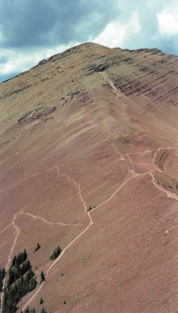
|
Clues:
1. Although the argillaceous sedimentary rocks pictured here are more than a billion years old, this mountain's distinctive appearance is the work of a giant thrust sheet from 75 million years ago and of the carvings of ice sheets in the past half-million years. 2. The peak is located in the world's first international peace park, so designated in 1932. 3. The trail visible in the photo crosses
the highest pass in the park in the course of its 18-kilometer journey
through montane, sub-alpine and alpine zones.
Scroll down for the answer
|
| Answer: Waterton Lakes National Park. Pictured is the Carthew-Alderson Trail. Photo by Caitlin Callahan. |
June 2002 winners:
1. Alejandro J. Benavides, Elko, Nev.
2. Jim Ferguson, Nashville, Ind.
3. Jeremy Malczyk, Ayer, Mass.
4. Carol Ormand, De Pere, Wisc.
5. Mike Ranck, Socorro, N.M.
6. Jeff Sanders, Alcalde, N.M.
7. Donald P. Schwert, Fargo, N.D.
8. Erin Taylor, Ayer, Mass.
9. Mari Vice, Platteville, Wisc.
10. Linda D. Winslow, Auburndale, Mass.
May 2002
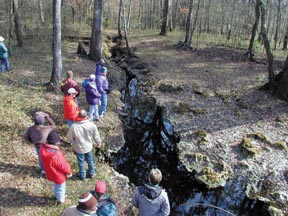
|
Clues:
1. This fissure hosts a spring that empties into a tributary of a river made famous by a composer who was known as a Southerner, but who grew up in New York. 2. The fissure is near a spring group popular with divers. Divers say the feature is more than 100 feet deep and opens into a cave. Three of the other springs are named for the body parts of Mephistopheles. The springs flow from one of the world's most productive karst aquifers. 3. The clothes of the people pictured contradict
the area's actual climate. Name the tributary or the spring group. Scroll down for the answer
|
| Answer: Sante Fe River or Ginnie Springs |
May 2002 winners:
1. Kyle Champion (Tampa, FL)
2. Violet Grossu (California)
3. Jim Humphrey (Midland, TX)
4. Jacq Marie Jack (Atlanta, GA)
5. Matthew Lewis (Farmers Branch, TX)
6. Annette Lyle (Boise, ID)
7. Jim Mayo (Weaverville, NC)
8. Arthur N. Palmer (Oneonta, NY)
9. Janice Sellers (El Cerrito, CA)
10. Michael Thomas (Jacksonville, FL)
April 2002
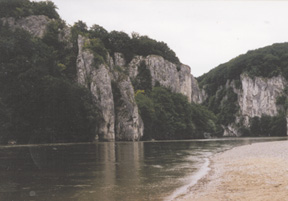
|
Clues:
1. Steep cliffs of Jurassic limestone squeeze this river into a narrow channel. The cliffs were once a frontier of the Roman Empire. 2. The oldest Benedictine monastery on this continent, founded in the seventh century, sits directly upstream. It is also the world's oldest monastic brewery, producing beer since the 11th century. 3. The river's color is celebrated in the
famous dance tune. Name the river and either the nearby town or monastery. Scroll down for the answer
|
| Answer: The Donaudurchbruch, or Danube Passage, along the Danube River, between Kelheim, Germany, and the Kloster Weltenburg, Europe’s oldest Benedictine monastery. Image supplied by Joseph F. Arndt of Irvine, Calif. |
April 2002 winners:
1. Hillman Bearden (Bedford, TX)
2. Michelle Dry (Memphis, TN)
3. Amanda Duchek (Urbana, IL)
4. Sam Hotchkiss (Chantilly, VA)
5. Frank M. Jacobeen (Locust Grove, VA)
6. Stan Sasser (Fayetteville, AR)
7. Robert W. Scott (Cleveland, OK)
8. Darrell Sofield (Tacoma, WA)
9. Gerd Tietz (Hamburg, Germany)
10. Matthias Zeitlhofler (Middletown, CT)
|
|
Clues:
1. This mountain's current name is the result of a misprint on an early map; it's original name reflected the fact that its length is more notable than its height. 2. High up on the face is a coal seam indicative of the age of the rocks exposed in the cut. The rusty seeps on the cut's face are the result of groundwater oxidizing pyrite associated with the coal. 3. This cut is home to a three-story geology museum
that receives between 120,000 and 150,000 visitors every year.
Name the place. Scroll down for the answer |
| Answer: Sideling Hill along Interstate 68 in western Maryland. Image by Kenneth Weaver. |
March 2002 winners:
1. Janet W. Crampton (Rockville, MD)
2. George R. Dasher (Elk View, WV)
3. Mary E. Dowse (Silver City, NM)
4. Pamela Gore (Clarkston, GA)
5. Bret Leslie (Vienna, VA)
6. Jim Lewis (Richardson, TX)
7. Sharon Lyon (Brookeville, MD)
8. Jason C. Sheasley (Jacksonville, FL)
9. Cheryl J. Sinclair (Williamsport, PA)
10. Rob Viens (Bellevue, WA)
February 2002
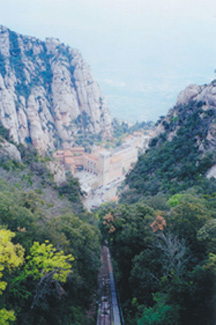
|
Clues:
1. Hermit monks built huts here around A.D. 900 and built a monastery in 1025. The town's church is home to a famous Black Madonna statue. 2. The spectacular columns and cliffs are composed of uplifted and differentially eroded Upper Eocene conglomerates that represent a stack of fluvial and deltaic deposits. 3. The town and mountains share their knife-edged
name with a famous volcano located in the West Indies. Name the town or mountain range. Scroll down for the answer
|
| Answer: Montserrat, Spain or Montserrat Mountains. Photo by Ron Kaufman. |
February 2002 winners:
1. Chris DeWolf (Mecosta, MI)
2. Henry L. Berryhill, Jr. (Corpus Christie, TX)
3. Neil C. Sturchio (Chicago, IL)
4. David McMullin (Wolfville, NS, Canada)
5. Barbara Faulkner (Houston, TX)
6. Ella A. Beasley (Citrus Heights, CA)
7. Sandra Stapp (Oceanside, CA)
8. Jim Shelden (Missoula, MT)
9. Bill Thomas (Plano, TX)
10. Arlo B. Weil (Bryn Mawr, PA)
January 2002
 |
Clues:
1. The name of the nearby mountain range is shaky. 2. Designated as a national monument in 2001, this place has a (non-ornate) name that is easily confused with a spicy sausage. 3. In addition to a world-class
fault exposure, rocks in the area contain abundant Miocene terrestrail
mammal fossils as well as marine mollusks, pectens, turitellas and oysters..
Name the place. Scroll down for the answer
... |
| Answer: An exposure of the San Andreas fault in the newly created Carrizo Plain National Monument in California. Photo supplied by Marcus Milling. |
January 2002 winners:
1. Scott Creely (Santa Cruz, CA)
2. Lynne Dickman (Stevensville, MT)
3. Ken Finger (Chino Hills, CA)
4. Anke Friedrich (Pasadena, CA)
5. Bob Given (Palos Verdes, CA)
6. Paul Heidgerd (Dallas, TX)
7. Anson Mark (Denver, CO)
8. Keith Meldahl (Oceanside, CA)
9. Toby Moore (Tustin, CA)
10. Michael Wopat (Redding, CA)
2000: January February March April May June July August September October November December
2001: January February March April May June July August September October November December
2002: January February March April May June July August September October November December
2003: January February March April May June July August September October November December
2004: January February March April May June July August September October November December
2005: January February March April May June July August September October November December
2006: January February March April May June July August September October November December
2007: January February March April May June July August September October November December
2008: January February March April May June July August

 Subscribe
Subscribe

